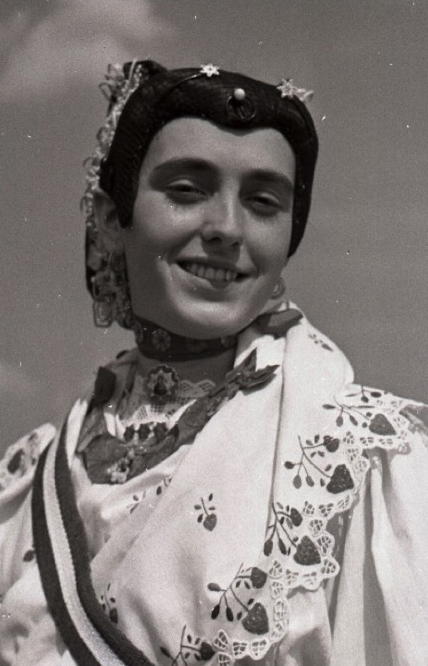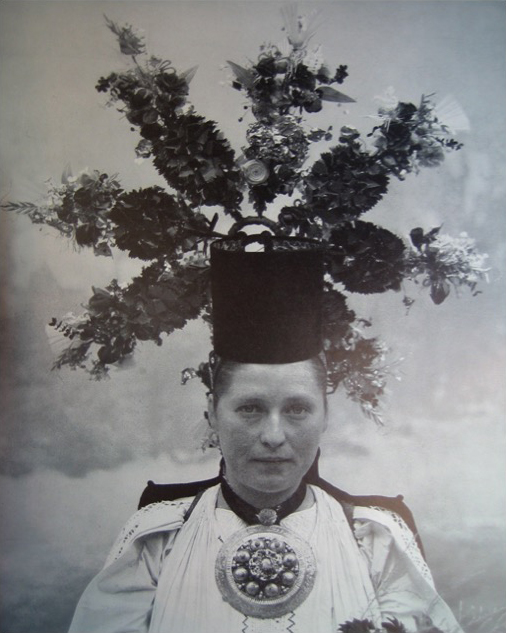Croatian photographer Tošo Dabac (1907-1970) has been regaining acclaim in recent years as a notable twentieth century photographer. The Dabac archive is housed in his original studio which he had kept since 1940 in a modernist office building with steel window frames and large rounded glass windows on Ilica Street in downtown Zagreb and holds around 200,000 mainly still uncatalogued negatives and more than 2,000 vintage prints. The objects are cared for by Marina Benažić and have been part of the local Museum of Contemporary Art’s collection since 2006. Publications on and exhibitions of his work have presented Dabac as a modernist, urban photographer. Indeed, much of Dabac’s work which was represented in several exhibitions in Western Europe and the US particularly in the 1930s, 1940s, and 1960s focused on the representation of street scenes in Zagreb from the 1930s such as the series Ljudi es ulice (People from the Street, 1932-35) and Na ulici (In the Street, c. 1940). Particularly the images from the series Na ulici with their cool, matter-of-fact aesthetic, sharp contrasts, and compositional strategies of distortion follow the formal language of New Objectivity, which was in vogue around 1930. Modernity and industrialization brought with them not only a specific mode of seeing but, crucially, a way of visually representing their cultural products.
Hence, a visit to the archive revealed a surprising aspect of Dabac’s work when the collection’s curator retrieved a pack of cardboard sheets each holding four standard size black-and-white photographs that represented young women in folkloristic costumes. One image in particular, part of a set of four, epitomizes the antagonistic forces of traditionalism versus modernization and modernism evident in Dabac’s photography as well as its historiography. The untitled photograph shows the head and torso of a young lady facing the viewer in a slightly downward pose. Her smiling face appears framed by a myriad of materials and shapes. Her bright white blouse and scarf are contrasted by dark (presumably colorful) embroideries, decorative applications and her tanned face upon which the bright sunlight casts dramatic shadows. More than anything, Dabac’s photograph reveals the desire to indulge in the material qualities of his subjects’ accoutrements–-fabrics, pins, embroidery lace, ribbons, and pearls are rendered magnificent. But its composition also highlights the strangeness of the costume: the young woman’s face is framed by an elaborate, pitch-black “traditional” hairstyle that is held in place not only by shiny metal pins with artificial, molded flowers, but by a synthetic hairnet. This choice of such a product was just as economical as the choice of the clearly machine-woven fine white fabric, whitework embroidery, and identifying sash.
Dabac’s untitled image of a young woman in folk costume most likely dates from around 1950. Indeed, Dabac made around 1,500 photographs of individuals and groups in folk costume between 1948 and 1950. He was fascinated with the folk comunity which he perceived as vibrant and different from his usual urban environment and milieu. In total, Dabac produced between 6,000-8,000 photographs with folk motifs throughout his entire career;they were intended for use in local history and touristic publications and were widely published. Interestingly, however, the folkore photographs are apparently considered „only“ as documentary images.
Within the art world, Dabac is imagined solely as a representative of a very narrow concept of artistic modernism within which his framing of folklore is regrettably ignored. In this view, the urban environment still seems like the only natural milieu for modernists, particularly artists, to engage in. In early twentieth century bohemian circles the city, not the countryside, was associated with modernization, due to its pace, density and omnipresence of industrial developments, but also because most artists chose to live in and represent modern city spaces. In addition, modernist artists also identified with urban spaces in order to rebel against the anti-industrial and anti-urban sentiments of early twentieth century conservatives, who had glorified rural lifestyles and “traditions” as uncontaminated by industrial, social, and economic changes. In the popular and reactionary German photographer Erna Lendvai-Dircksen’s (1883-1962) view, the urban population was tragic compared to its rural counterpart: „The city human has the targic face of our times. It is not anymore and not yet.“ In reality, modernization and industrialization were just as pervasive in the countryside–not just in form of modern corporations and infrastructure, but also in form of consumer culture, trade, and social customs.
Twentieth century fantasies were indeed often reified and visualized as faces, houses, and landscapes. Several early twentieth century portrait projects were understood as comprehensive attempts to picture an unstable society through the typification of supposedly quintessential types. Dabac’s folklore photo series are hardly a useful tool for empiric systematization, nor are they examples of an exercise in the classical ideal of epistemology wherein knowledge is acquired and advanced through continuous ordering and registering of differences. His compendium of subjects in folkloristic costume, however, provides a fascinating modernist narrative of national identity and formation within the particularly complex concept of an ethnic or national Croatian communal identity in Croatia’s long and difficult history of ethnic and national struggles and allegiances. The importance of images for what Benedict Anderson calls the “imagined” national community cannot be underestimated. Large ethnic or national communities exist only as concepts and are manifested in either mental images or, as is often the case in the early twentieth century, visual images. Even more so, folk images in particular lend further credibility to the authenticity of such imagined communities as they suggest their heritage, and therefore a longstanding tradition. Particularly folk tradition, in turn, suggests the continuity of a (likewise) imagined pre-industrial past. And using “folk” tradition as a means to establish the sense of a contiguous national history was a common conservative strategy in the turbulent twentieth century, particularly in mid-century Western Europe. Photography played an eminent role in establishing visual evidence of what was, in actuality, an invented national tradition. Therefore, agglomerations of images of citizens in folk costumes, for instance, could have suggested the desire for if not a unified, at least a merry gathering of Yugoslav, or more specifically Croatian, population, for instance at the great folk festival in Medulin in 1951.
The image of what appeared as rural life to the city dweller was often consciously and openly constructed, for instance in the work of German photographer Hans Retzlaff (1902-1965) who, as opposed to Tošo Dabac, is known mainly for his folkloristic portraits, which have, also different for Dabac’s work, been studied sparsely with regards to their complicated terms of production. Typical of Retzlaff’s work were the photos in his book Die Siebenbürger Sachsen. Antlitz eines deutschen Bauernstammes, which features 96 photographs (only a fraction of the many he took, which were later published elsewhere) mainly portraying individuals in folkloristic costume, interspersed with a few images of people at work or at church and some views of villages and farmyards. As is evident in his photographs, Retzlaff was particularly fascinated with the ethnic group’s costume, which he described as a remarkable creative outlet that at the same time signals social status not only with regard to economic means, but also according to familial and generational status. Retzlaff’s descriptions of his subjects are filled with wonderment concerning the survival of this group and their customs even if, in reality, it was no longer common for rural populations to wear costumes, or Tracht, by the 1930s when Retzlaff took his photos. The folkloristic costumes, which had changed continuously and considerably throughout their history, were not part of everyday life, but donned by whichever local (or external) resident would volunteer to pose for Retzlaff’s photos. Just like Dabac, Retzlaff highlighted the elaborate fabrication and lavish use of mass-produced materials in a modernist style: One photo Braut aus Rode (ca. 1930), depicts a woman from a plain frontal view; her face, however, is not centered but located in the bottom half of the image because of a very large radial ornament (about fifty centimeters in diameter) attached to the back of her high, pitch-black hat. The ornament’s eight rays, according to Retzlaff, were decorated with (presumably industrially produced) artificial flowers and metallic glitter and required the wearer to move in a prescribed manner. Retzlaff emphasized the outlandishness of the Siebenbürger costume, which he compared to déclassé Rococo as implicitly fussy and frivolous: “The soft skirts of gauze in a bell-shaped billow, the blouse-sleeves aromatic and soft. The rich colors of the flowered bodice cushioned with plush tufts, here Rococo-costume is still in full vitality.“
Though Retzlaff’s work was later popular with the German National Socialists due to the theoretical wholesomeness of its rural subject matter, Retzlaff’s early photographs documenting the “Siebenbürger Sachsen” display a voyeuristic ethnographic passion rather than the stylized control visible, for instance, in Erna Lendvai-Dircksen’s photographs. The ethnographic photograph was one of the most important tools in the disciplinary establishment of anthropology by the mid-nineteenth century. By 1901, anthropologist Rudolf Martin published a treatise on the academic teaching of anthropology, citing an “enormous expansion of the geographical horizon” of German anthropologists who had ventured to “exotic” destinations like Africa or China in the preceding years. However, around 1900, focusing on “typical” material manifestations of national history, many late nineteenth century reformers were particularly enthusiastic about the possibilities to document rural culture via photographs. Even more so, the quest for ethnographic cataloguing during the 1930s led to the exploration of a new exotic “Other” in the countryside: “Destinations did not have to be as exotic as Asia, mysterious as Africa, or adventurous as America’s ‘Wild West’–-sometimes a neighboring village was far enough away to allow a photographer to see things and people with the eyes of an outsider or ethnographer […].
Lastly, rapid industrialization through travel and technology also provided the means not only to capture the culture whose decline it was supposedly causing, but also ethnographers believed themselves to have found a “realistic” medium for representation through photography itself. Paradoxically, the popularity of clothing in a folkloristic style as well as its representation was also a result of industrialization. Celia Applegate points to the invention of folklore in the case of the inhabitants of the German Palatinate, whose artificial, often mass-produced folkloristic costume was meant to “seek some common denominator, some cultural heritage available to all. […] Folklore became the repository of a wide-spread longing, not for the bygone past as such, but for the unalienated, undivided life.” But while twentieth century images of folk costume are sometimes characterized by the desire to construct an image of a supposedly pre-industrial style, the precise and clear formal language of modernist photography in the case of Tošo Dabac and Hans Retzlaff exposes the circumstances of industrial production of folk costume materials, epitomizing the concurrent and colliding forces of modernity, industrialization, and modernism in twentieth century Eastern Europe.






